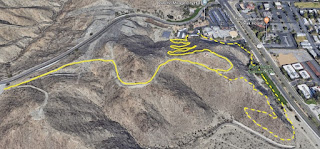 |
| The Jack Rabbit Trail runs from the Cancer Survivors Park to Frank Sinatra Drive in tony Rancho Mirage, California. |
 |
| Aerial map of Big Horn Overlook Trail and Jack Rabbit Trail; the broken line route is a loop to the Cancer Survivors Park. Click for larger version. |
Day hikers can enjoy impressive views of the Coachella Valley’s middle cities on two Rancho Mirage trails.
Combining the Big Overlook Trail and a segment of the Jack Rabbit Trail takes hikers on a 1.6-mile round trip. A shorter alternative is to hike the Big Overlook then take the Jack Rabbit to the Richard & Annette Bloch Cancer Survivors Park for a 0.75-mile loop.
To reach the trailhead, from Calif. Hwy. 111, turn west onto Frank Sinatra Drive and then left/south into the Rancho Mirage City Hall complex. When the entry road splits, go right/west and park in the upper lot at the Big Horn Overlook Trailhead. The trail heads into the foothills on the lot’s south side.
The Big Horn Overlook Trail switchbacks up a foothill, offering increasingly good views of Rancho Mirage and Palm Desert, and on the other side of the valley floor the Little San Bernardino Mountains. Part way through the fourth switchback, you’ll enter the Santa Rosa and San Jacinto Mountains National Monument.
While a mere 0.2 miles in length until reaching the foothill overlook, the trail is uphill all the way – and ascending for 100 feet in such a short distance is not for the out of shape. Fortunately, a shelter at the trail’s top gives you a place to catch your breath. It’s also a great spot for a picnic, so just doing the Overlook trail to the shelter is a nice 0.4-miles round trip hike.
From the overlook, follow the jeep trail southeast as it curves around the foothill’s edge. In less than 0.1 miles, the path ends as it reaches the Jack Rabbit Trail.
Jack Rabbit Trail
If you go left/southeast, the Jack Rabbit Trail serpentines down the foothill to the verdant Cancer Survivors Park along Hwy. 111. Rather than take that steep route, which heads back to the urban noise, instead go straight/east deeper into the foothills.
The Jack Rabbit Trail largely follows the foothill’s edge then gradually descends toward Frank Sinatra Drive. It’s 0.3 miles one-way.
If walking the trail in spring or within a day or two after a rainfall, you’ll likely see desert wildflowers along the way.
Upon reaching the entry road from Frank Sinatra Drive to the water tanks, retrace your steps back to the parking lot. Do not walk Frank Sinatra Drive back in a loop, though, as there are no sidewalks and at several spots no shoulder.
Cancer Survivors Park
Should you decide to hike the Jack Rabbit Trail to the Cancer Survivors Park and back, that will add 0.7 miles to the route. The beautiful, moving park certainly is worth the extra steps – ponds, a hillside waterfall, a sculpture garden, tiled benches, and a pyramid kiosk fill one acre of greenery. A moving sight, the park celebrates life while inspiring cancer patients with the will to fight. The park’s highlight is the sculpture “Cancer…there’s hope” made of eight near life-size human figures that head through an abstract tunnel. Mexican sculptor Victor Salmones created the artwork.
The park is one of 22 across the nation dedicated to cancer survivors that were funded by the estate od Richard Bloch, the former CEO of H&R Block, after his passing in 2004. Bloch had survived both lung cancer, which he was diagnosed with in 1978, and colon cancer, which he was diagnosed with in 1990. Bloch and his wife Annette were active in cancer philanthropy for a quarter of a century.
Of course, returning to the Jack Rabbit Trail junction with the Big Horn Overlook Trail means heading back uphill. An alternate is to simply continue walking north back to the city hall complex for about a 0.1-mile walk to your parking lot.
Except for the trailhead and Cancer Survivors Park, the route is entirely open to the sun, so be sure to don sunscreen, sunglasses and sunhat. Dogs are allowed on the trail if leashed.
